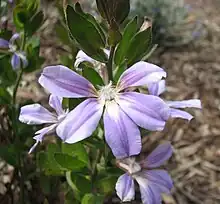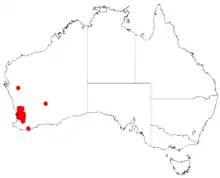| Scaevola platyphylla | |
|---|---|
 | |
| Scientific classification | |
| Kingdom: | Plantae |
| Clade: | Tracheophytes |
| Clade: | Angiosperms |
| Clade: | Eudicots |
| Clade: | Asterids |
| Order: | Asterales |
| Family: | Goodeniaceae |
| Genus: | Scaevola |
| Species: | S. platyphylla |
| Binomial name | |
| Scaevola platyphylla | |
 | |
| Occurrence data from Australasian Virtual Herbarium | |
| Synonyms[3] | |
|
Lobelia platyphylla (Labill.) Kuntze | |
Scaevola platyphylla, commonly known as broad-leaved fanflower, is a shrub in the family Goodeniaceae. It is endemic to the south-west of Western Australia. Plants grow to between 0.3 and 1.3 metres high and have blue to purple flowers that appear between August and January in their native range.[4]
The species was formally described in 1839 by English botanist John Lindley in A sketch of the vegetation of the Swan River Colony.[1][2]
Gallery
References
- 1 2 "Scaevola platyphylla". Australian Plant Name Index (APNI), IBIS database. Centre for Plant Biodiversity Research, Australian Government, Canberra. Retrieved 17 November 2012.
- 1 2 Lindley, J. (1839) A Sketch of the Vegetation of the Swan River Colony: xxvi.
- ↑ "Scaevola platyphylla Lindl. | Plants of the World Online | Kew Science". Plants of the World Online. Retrieved 29 March 2020.
- ↑ "Scaevola platyphylla". FloraBase. Western Australian Government Department of Biodiversity, Conservation and Attractions.
This article is issued from Wikipedia. The text is licensed under Creative Commons - Attribution - Sharealike. Additional terms may apply for the media files.
.jpg.webp)
.jpg.webp)